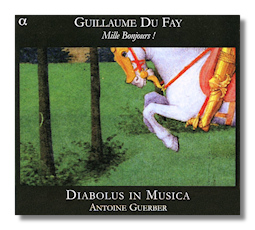
The Internet's Premier Classical Music Source
Related Links
- Dufay Reviews
- Latest Reviews
- More Reviews
-
By Composer
-
Collections
DVD & Blu-ray
Books
Concert Reviews
Articles/Interviews
Software
Audio
Search Amazon
Recommended Links
Site News
 CD Review
CD Review
Guillaume Dufay
Mille Bonjours!

- Pour ce que je ne puis (Rondeau)
- Helas mon dueil, a ce cop sui je mort (Bergerette)
- MIlle bonjours je vous présente
- Helas, et quant vous veray?
- Je languis en piteux martire (Ballade)
- Mon chier amy, qu'avés vous empensé (Ballade)
- Mit ganzem Willen
- C'est bien raison de devoir essaucier (Ballade)
- Resvelliés vous et faites chiere lye (Ballade)
- Franc cuer gentil, sur toutes gracieuse
- Franc cuer gentil, sur toutes gracieuse (Rondeau)
- S'il est plaisir que je vous puisse faire (Bergerette)
- Par le regard de vos beaux yeux (Rondeau)
- Se la face ay pale
- Je veuil chanter de cuer joyeux (Rondeau)
- Mille bonjours je vous presente
- Entre vous gentils amoureux (Rondeau)
- Puisque vous estez campieur (Rondeau)
- He compaignons resvelons nous (Rondeau)
Diabolus In Musica/Antoine Guerber
Alpha 116
Dufay, writing in fifteenth century, is a figure of greater variety (and much greater profundity, for that matter) than is often realized. Attracting an enormous following and widespread admiration in Europe throughout his long lifetime, he wrote primarily for the church: Dufay was an ordained priest. But he used many forms – from elaborate and florid polyphonic masses to simple songs. And secular songs at that: over 80 survive which may in part or whole be safely attributed to the composer. If it is possible to generalize, one would say that Dufay's earlier songs were more extrovert, happier, upbeat, than those composed before the trials his life brought him; the later works tend to be reflective, morose even.
These songs generally date from two distinct periods in Dufay's life… from his late teens in 1414, 1415 on his leaving Cambrai to travel to various European courts, where he would have heard a variety of styles from England and Italy as well as France; this lasted until 1439, when Dufay returned to Cambrai. Duties at the Burgundian court and the cathedral virtually precluded any but liturgical compositions – until after Dufay's move, after 1451, to the court of Duke Louis and Duchess Anne of Savoy, whom we know to have been lively patrons of also the kind of secular music, the chansons by Dufay, some of which form the substance of this atmospheric, well-performed and appropriately-contextualized CD from Diabolus in Musica.
The majority of Dufay's output of this kind is rondeaux (with some ballades) for three (some for four) voices. The rest mostly follow such established structures as the ballade, bergerette/virelai and the like. Two tenors take the parts of the fundamental voice part (tenor), superius with the main text line; and a high voice the contratenor for additional color. These are taken by Raphaël Boulay (tenor), Frédéric Betous and Andrès Rojas-Urrego (altos) and Aïno Lund-Lavoipierre (soprano). They sing with unfussed enthusiasm, sweetness and an accurate and expressive articulation that seems to come from within the music's spirit, rather than gliding along the top of the melody as has happened with some recent Dufay recordings. This is highly effective. Nor – whatever your reservations about accompaniment – are the clavicytherium (an early spinet with as much hammer noise as sweet key sounds), gittern (plucked strings) and vièle (medieval fiddle) intrusive or superfluous. Their euphonic, low key adds a mellow tinge to the singing. It's worth noting that Guerber, the author of the essay in the accompanying booklet, disputes the work of recent musicologists and suggests that there is little or no evidence for an a cappella (unaccompanied) performing tradition, and cites Patterns in Play (by Graeme Boone) in support of what will be a somewhat controversial conclusion.
Technically what Dufay does to develop the achievements of the earlier and by now defunct Ars Subtilior is remarkable. Not only because of the inventiveness of theme, texture and melody; but also in terms of contrapuntal rhythm, the beauty of the effects and the fitness of music to words.
Those texts were almost all in the French of his day (only a handful were in Italian); although there are settings of Petrarch, Le Rousselet and Perinet etc, it is probable that Dufay wrote much of his own poetry.
The recording is a nice, close and intimate one with perfect balance between singers and the four instrumentalists playing here. The text of all the songs is printed in French and English in a useful, glossy booklet in the Alpha 'digipak' with candid photographs of the performances and performers. Guerber makes some interesting speculations on just who would have performed such songs as these and suggests that those retained for sacred music were unlikely also to have worked on the songs we hear on this CD. Less because of any distinction between the sobriety of the one and the freer and easier often dance-inspired ways of the other, than between the type of skills and traditions on which each broad genre was based.
So, if this is repertoire which in any way interests you, here is a first class introduction. If you're already persuaded of Dufay's greatness, you'll want to extend your exposure to his secular music. If medieval song performed exquisitely and idiomatically in unpretentious and direct manner, then do not hesitate to buy this CD. Thoroughly recommended.
Copyright © 2008, Mark Sealey




















